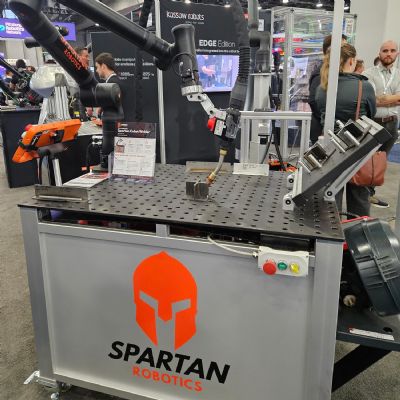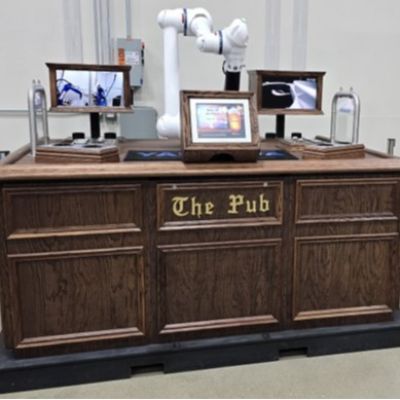Needed Answer for Tedious, Labor-Heavy Machine Feeding
The process: picking complex stamped components, jumbled together in bins, then placing the components in precise orientation on an automated conveyor for assembly. The solution: SMB chose the Universal Robots (UR) ActiNav machine-tending kit. Incorporation of the kit, according to Schaeffler officials, yielded improved labor utilization and productivity on the previously manually attended lines.
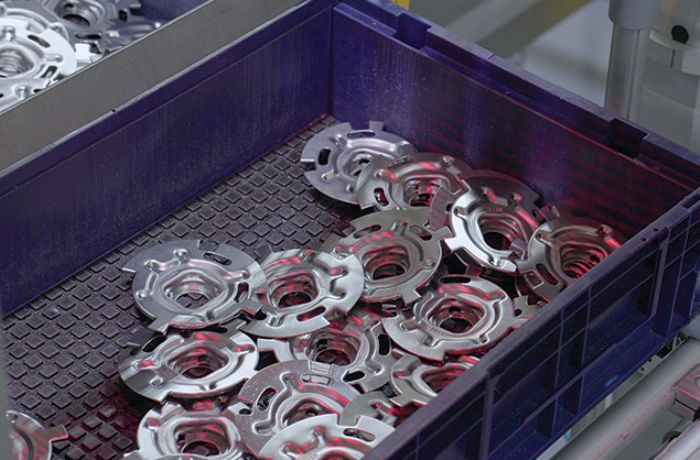 The solution revolved around 24/7 manufacturing lines at Cheraw that produce a variable cam timing system (VCT) designed to improve performance and reduce emissions in internal combustion engines. Previously, four operators oversaw and fed the assembly lines, ensuring the accurate orientation of components’ complex geometries for successive processes. The location of the lines far from other equipment prevented operators from working in other areas. And, operators leaving for breaks or other reasons would halt production.
The solution revolved around 24/7 manufacturing lines at Cheraw that produce a variable cam timing system (VCT) designed to improve performance and reduce emissions in internal combustion engines. Previously, four operators oversaw and fed the assembly lines, ensuring the accurate orientation of components’ complex geometries for successive processes. The location of the lines far from other equipment prevented operators from working in other areas. And, operators leaving for breaks or other reasons would halt production.
Schaeffler, like many manufacturers, faces difficulty in hiring and retaining employees for these repetitive manual operations.
“We needed to increase our output on these lines and somehow create more efficiency,” recalls Mike Reed, VCT production leader. “The 8 hr./day of performing the same job can be cumbersome and boring.”
Automating the repetitive process would allow Schaeffler to reduce downtime and lost production, and allow for operator allocation to other processes. The Schaeffler team sought automation on this line previously, but not until witnessing ActiNav at a tradeshow did a solution present itself. Soon after the show, Bruno Waldmann, SMB mechanical design group leader, and his project team quickly reached out to Cimtec Automation, a UR distributor. Within days, ActiNav was demonstrating successful picking and placing of Schaeffler’s stampings, utilizing a key advantage of the ActiNav system: its ability to autonomously pick parts, randomly oriented in a bin, and accurately place them.
Designed for machine-loading applications, UR’s ActiNav, part of the UR+ Application Kit portfolio, synchronously handles vision processing, collision-free motion planning, bin picking and autonomous real-time cobot control. The kit includes the ActiNav autonomous motion module; a 3D sensor placed above the bin; user interface; alignment marker; all cables, screws and brackets; and UR’s e-series cobot—UR5e, UR10e or UR16e model. Schaeffler employs a UR5e cobot, with reach to 850 mm and 5-kg payload capacity, in this application.
Small-Footprint Automation Hits Cycle-Time Goal
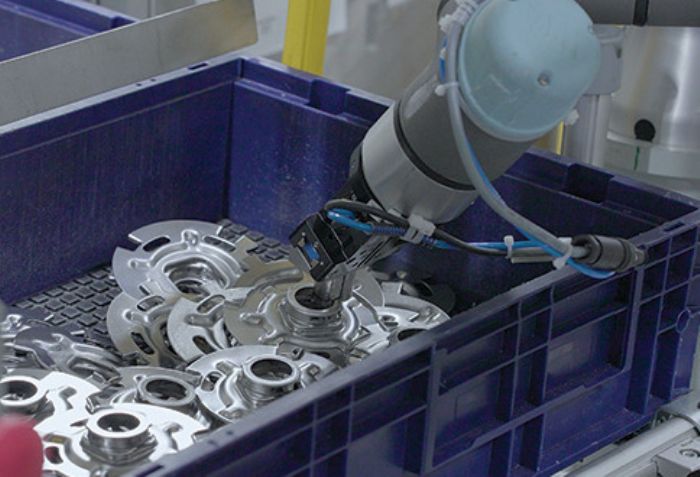 Using the new ActiNav station, installed in 2021, an operator simply dumps components into multiple bins and then moves to another process. This provides the system with about 2 hr. of work without requiring an operator. With parts in the bins, the ActiNav 3D sensor scans a bin, which allows the system to calculate appropriate picks for the cobot. After picking, the cobot picks and places a face-up part directly on the conveyor, and places face-down parts into a reorientation station that flips the part to allow the cobot to repick it and place it accurately on the conveyor. Then, the conveyor transfers placed parts to the next assembly cell. An empty bin triggers the cobot to initiate a bin-change sequence, enabling it to continue picking from the next bin, without operator intervention.
Using the new ActiNav station, installed in 2021, an operator simply dumps components into multiple bins and then moves to another process. This provides the system with about 2 hr. of work without requiring an operator. With parts in the bins, the ActiNav 3D sensor scans a bin, which allows the system to calculate appropriate picks for the cobot. After picking, the cobot picks and places a face-up part directly on the conveyor, and places face-down parts into a reorientation station that flips the part to allow the cobot to repick it and place it accurately on the conveyor. Then, the conveyor transfers placed parts to the next assembly cell. An empty bin triggers the cobot to initiate a bin-change sequence, enabling it to continue picking from the next bin, without operator intervention.
“This solution allows us to minimize the footprint and eliminate a lot of peripheral equipment,” Parker says, “by picking parts directly from the bin and placing them into the carrier or on the pallet that then goes into the assembly machine.”
One challenge for this application: the ability to meet a cycle-time requirement for the assembly process.
“When we started researching this project, we looked for regularity—something that could meet the needed cycle time,” Waldmann says. “Precision also was important, not only for dropping the parts but for placing them in exact locations. The ActiNav system easily meets all of these requirements. The cobot isn’t the bottleneck on this line.”
The automation application, delivering a 15-sec. cycle time, proves an ideal fit for cobots, according to Parker.
“When switching from a robot to a cobot, you sacrifice payload capacity and speed,” he says. “This application lends itself very well to the cobot, being that we were giving up that speed factor as compared to using a robot. The stamped parts have a lot of sharp edges, which means that we must be careful how we sling the parts around, even though the UR system monitors the force being generated.”
To ensure the safety of associates, the application features open surrounding space with some hard guarding. Also, each part weighs only about 75 grams, with the cobot end effector only weighing 1 kg, according to Waldmann—well within the cobot’s payload capacity.
“The reach is what defined the cobot size for this application,” Waldmann says. “We could have used a small robot, but we wanted a flexible system where an operator can go in and check on things, or work alongside the cobot if needed.”
ROI in Less than One Year
Immediately upon initial operation, ActiNav reduced labor requirements from four operators on the VCT line to three, with the freed operator moved to higher-precision tasks on another line. That provided a return on investment in less than a year. By automating the process, Schaeffler has eliminated downtime and labor underutilization, and boosted overall equipment effectiveness on the line, with production efficiency improving by seven percent over the first three months of operation.
The UR5e powering the ActiNav system joins dozens of other UR cobots in Schaeffler facilities around the world.
“We want to use modularity as much as possible,” Parker explains. “We don’t want to keep introducing learning curves—if we can find one best-fit solution, it will help us with many different applications.”
He and his team within SMB are looking to integrate the ActiNav bin-picking application in other assembly processes, while also seeking additional application opportunities for production customers.
“Most importantly for us, we wanted to find a system that was developed, that was working, and that we would not have to invest so many hours in to get it off the ground,” Parker concludes. “We can take this and plug it in somewhere else. Because this system has worked so well, it’s made me optimistic about using it in other stations and in other areas.” MF
See also: Universal Robots
Technologies: Pressroom Automation







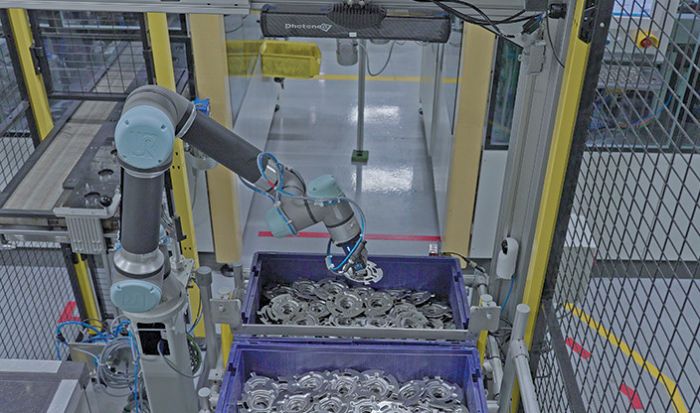 That’s Marty Parker, director of Sondermaschinenbau (SMB) Americas, Schaeffler Group’s special machinery group, describing how the 75-yr.-old manufacturer has maintained a proactive stance toward automation.
That’s Marty Parker, director of Sondermaschinenbau (SMB) Americas, Schaeffler Group’s special machinery group, describing how the 75-yr.-old manufacturer has maintained a proactive stance toward automation. 